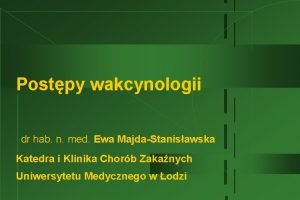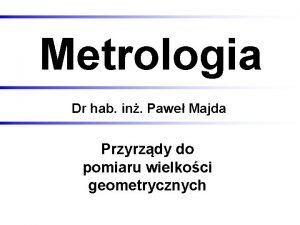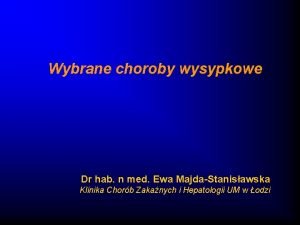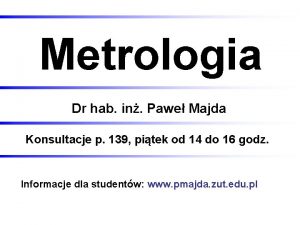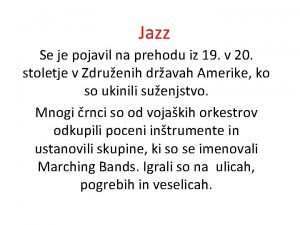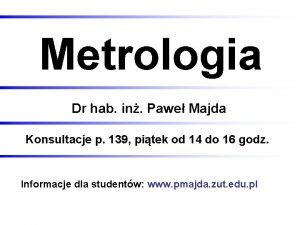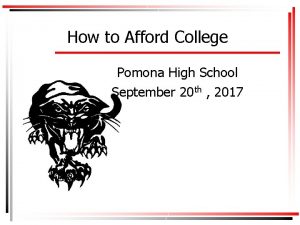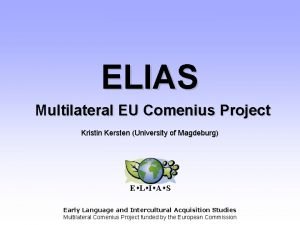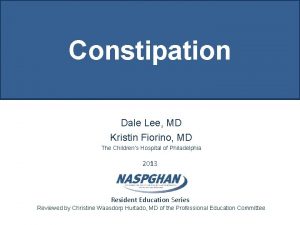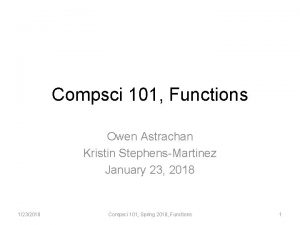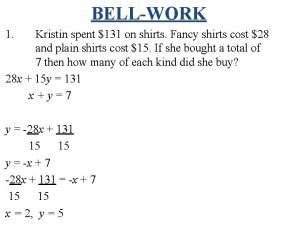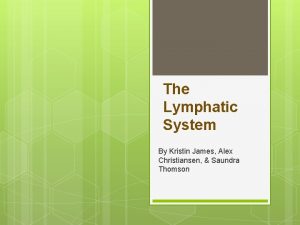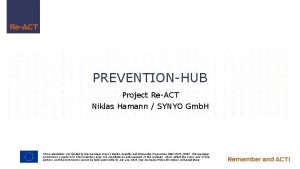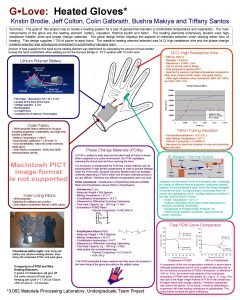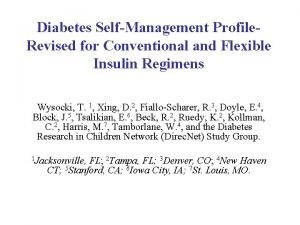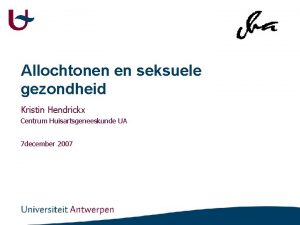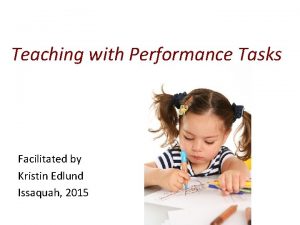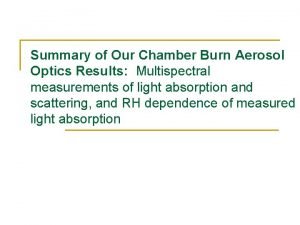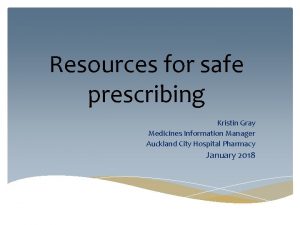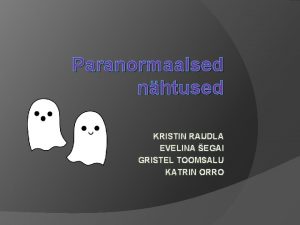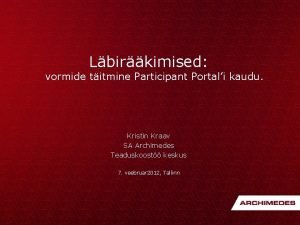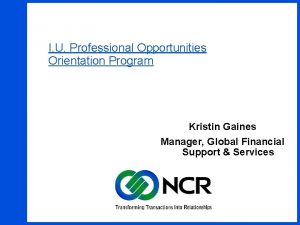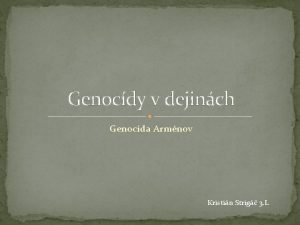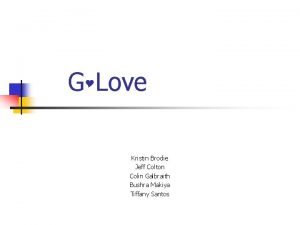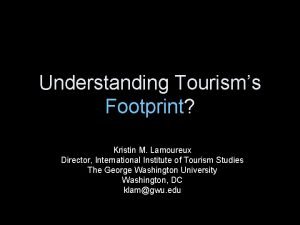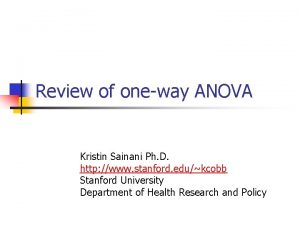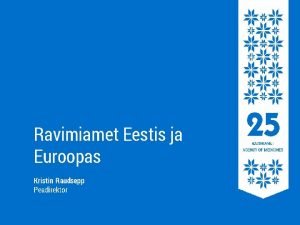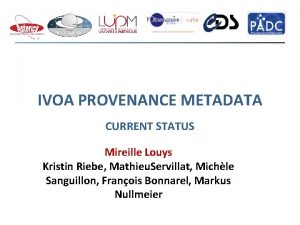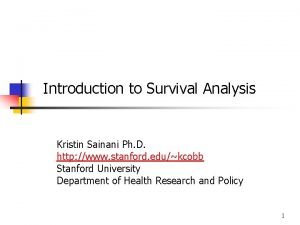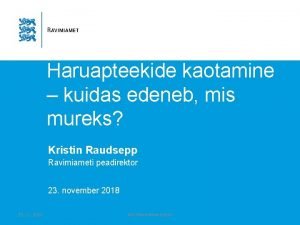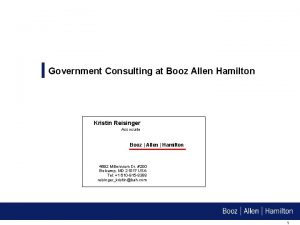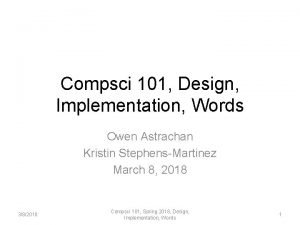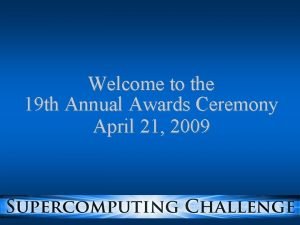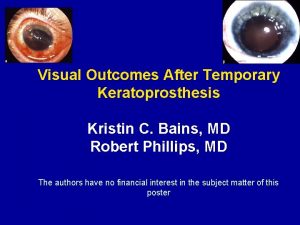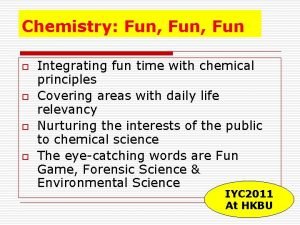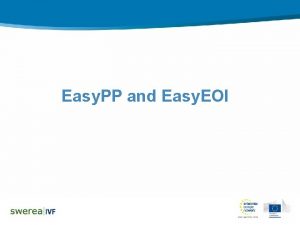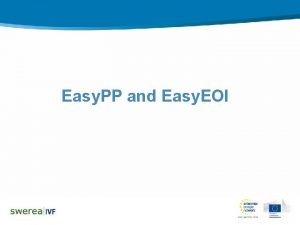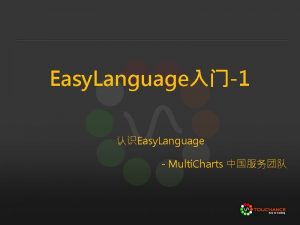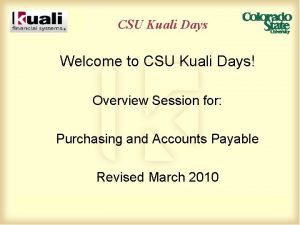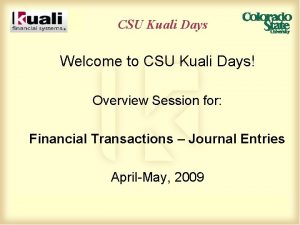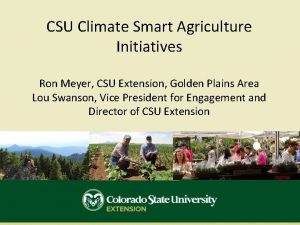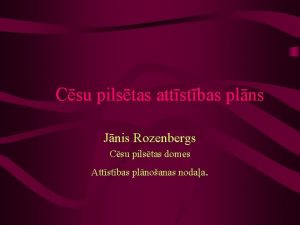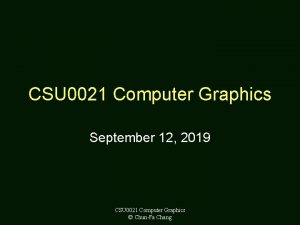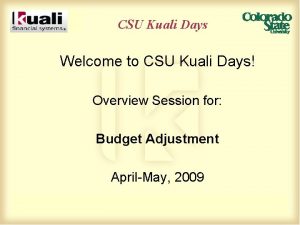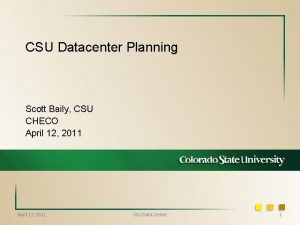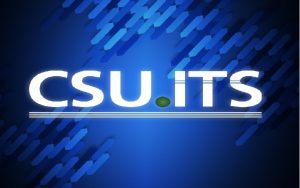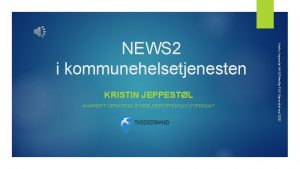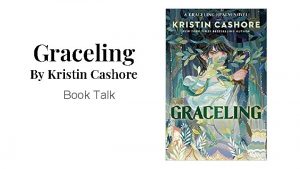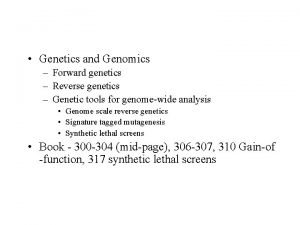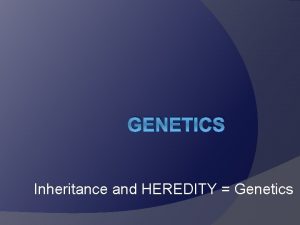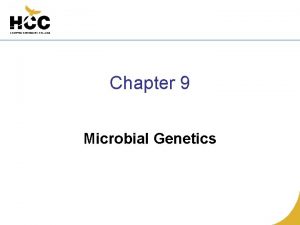Making Genetics Easy and Fun Kristin Majda CSU



















































- Slides: 51

Making Genetics Easy and Fun! Kristin Majda CSU Channel Islands kristin. majda 415@csuci. edu

Making Genetics Easy and Fun! Kristin Majda Education • BS Biology & Minor in Professional Writing, U. C. Santa Barbara • Single Subject Clear Credential with CLAD, Cal State Northridge • MS Biotechnology & MBA, Cal State Channel Islands Experience • Technical Writer • Ventura County High School Science Teacher • Oxnard College Instructor: Biology, Microbiology • CIRM Grant Analyst at Cal State Channel Islands • VP of Gold Coast Science Network (GCSN), Operating Council for the Discovery Center for Science and Technology, Bio Science Alliance (BSA) Workforce Development Group, American Association for the Advancement of Science (AAAS)

Agenda Making Genetics Easy and Fun! This presentation intends to: 1. Demonstrate a fun lesson teachers can use to reinforce concepts of meiosis and Mendelian Genetics 2. Introduce teachers to excellent resources for understanding and teaching genetics and biotechnology

Making Genetics Easy and Fun! Fun Activities 1. Lung Model (not genetics, but super cool!) 2. Mitosis and Meiosis Play Dough Activity 3. Mitosis and Meiosis Puzzle Activity 4. Protein Synthesis Modeling Activity (using the Preproinsulin sequence) ü Can integrate peer-reviewed journal articles into the curriculum using this lesson based on the 1980 paper that solved the structure of insulin “Nucelotide Sequence of Human Preproinsulin Complementary DNA” published in Science.

Making Genetics Easy and Fun! Fun Activities 1. Lung Model (not genetics, but super cool!) 2. Mitosis and Meiosis Play Dough Activity 3. Mitosis and Meiosis Puzzle Activity 4. Protein Synthesis Modeling Activity (using the Preproinsulin sequence) ü Can integrate peer-reviewed journal articles into the curriculum using this lesson based on the 1980 paper that solved the structure of insulin “Nucelotide Sequence of Human Preproinsulin Complementary DNA” published in Science.

Mitosis Class Activity Use play dough to act out the steps of mitosis 1. Prophase • Chromatin condenses to form chromosomes • Mitotic spindle begins to form 2. Metaphase • Mitotic spindle attaches to chromatid pairs and pulls them into alignment at center of cell 3. Anaphase • Centromeres replicate • Mitotic spindle pulls chromatids apart to opposite sides of cell 4. Telophase • The cell membrane invaginates and pinches off between the two daughter cells Interphase DNA Synthesis

Meiosis Class Activity Use play dough to act out the steps of meiosis Prophase I 2. Chromatids pair up Anaphase I 5. Random Assortment 3. Crossing over Telophase I 6. Cytokinesis Interphase 1. DNA Synthesis Metaphase I 4. Chromatid pairs line up 7. Prophase II 8. Metaphase II 9. Anaphase II 10. Telophase II

Making Genetics Easy and Fun! Fun Activities 1. Lung Model (not genetics, but super cool!) 2. Mitosis and Meiosis Play Dough Activity 3. Mitosis and Meiosis Puzzle Activity 4. Protein Synthesis Modeling Activity (using the Preproinsulin sequence) ü Can integrate peer-reviewed journal articles into the curriculum using this lesson based on the 1980 paper that solved the structure of insulin “Nucelotide Sequence of Human Preproinsulin Complementary DNA” published in Science.

Making Genetics Easy and Fun! Paper Bag Pets: A Genetics Project 1. Decorate a “pet” paper bag with traits that adhere to a given set of phenotype choices 2. Fill in Table of Alleles and create chromosomes for your paper bag pet that reflect its genotype for each trait 3. Create gametes for your pet paper bag 4. Find a mate and procreate 5. Fill out the Punnett square worksheet to predict the traits of your offspring 6. Give birth: decorate your baby bag with phenotypes that match its genotypes and fill out the birth certificate

Making Genetics Easy and Fun! Paper Bag Pets: A Genetics Project 1. Decorate a “pet” paper bag with traits that adhere to a given set of phenotype choices Reinforce and help students differentiate between phenotype and genotype 2. Fill in Table of Alleles and create chromosomes for your paper bag pet that reflect its genotype for each trait Reinforce that genetic traits are determined by genes, which are found on chromosomes 3. Create gametes for your pet paper bag 4. Find a mate and procreate Demonstrate the difference between autosomes and sex chromosomes 5. Fill out the Punnett square worksheet to predict the traits of your offspring 6. Give birth: decorate your baby bag with phenotypes that match its genotypes and fill out the birth certificate Demonstrate that many organisms, like humans, have two sets of each gene unless it occurs on the Y chromosome

Making Genetics Easy and Fun! Paper Bag Pets: A Genetics Project Decorate a “pet” paper bag with traits that adhere to this given set of phenotype choices: Gender male or female? Tail tail or no tail? (females cannot have tails) Eye Shape round or oval (almond) shaped? Eye Color brown, blue, green, yellow? Eyelashes has eyelashes or is lashless? Nose Shape circular or triangular? Hair Color black, brown, or yellow? Ear Shape round or pointed?

Making Genetics Easy and Fun! Paper Bag Pets: A Genetics Project Fill in Table of Alleles for your paper bag pet that reflect its genotype for each trait

Making Genetics Easy and Fun! Paper Bag Pets: A Genetics Project Create chromosomes for your paper bag pet that reflect its genotype for each trait For Females

Making Genetics Easy and Fun! Paper Bag Pets: A Genetics Project Create chromosomes for your paper bag pet that reflect its genotype for each trait For Males

Making Genetics Easy and Fun! Paper Bag Pets: A Genetics Project 1. Decorate a “pet” paper bag with traits that adhere to a given set of phenotype choices Reinforce and help students differentiate between phenotype and genotype 2. Fill in Table of Alleles and create chromosomes for your paper bag pet that reflect its genotype for each trait Reinforce that genetic traits are determined by genes, which are found on chromosomes 3. Create gametes for your pet paper bag 4. Find a mate and procreate Demonstrate the difference between autosomes and sex chromosomes 5. Fill out the Punnett square worksheet to predict the traits of your offspring 6. Give birth: decorate your baby bag with phenotypes that match its genotypes and fill out the birth certificate Demonstrate that many organisms, like humans, have two sets of each gene unless it occurs on the Y chromosome

Making Genetics Easy and Fun! Paper Bag Pets: A Genetics Project 1. Decorate a “pet” paper bag with traits that adhere to a given set of phenotype choices 2. Fill in Table of Alleles and create chromosomes for your paper bag pet that reflect its genotype for each trait 3. Create gametes for your pet paper bag 4. Find a mate and procreate 5. Fill out the Punnett square worksheet to predict the traits of your offspring 6. Give birth: decorate your baby bag with phenotypes that match its genotypes and fill out the birth certificate Demonstrate the steps of meiosis and how this process promotes genetic variation through mutations (that occur during DNA replication), crossing over, and random segregation/assortment Demonstrate the law of independent assortment Demonstrate how meiosis results in four genetically unique gametes Demonstrate how sexual reproduction promotes genetic diversity through fertilization (joining gametes from two different individuals)

Making Genetics Easy and Fun! Paper Bag Pets: A Genetics Project Create gametes for your pet paper bag Step 1: DNA replication For Females For Males

Making Genetics Easy and Fun! Paper Bag Pets: A Genetics Project Create gametes for your pet paper bag Step 2: Crossing Over Step 3: Random Assortment Step 4: First cell division Crossing Over Random assortment

Making Genetics Easy and Fun! Paper Bag Pets: A Genetics Project Create gametes for your pet paper bag Step 5: Second cell division

Making Genetics Easy and Fun! Paper Bag Pets: A Genetics Project Find a mate and procreate This is their FAVORITE part Students LOVE to have SEX

Making Genetics Easy and Fun! Paper Bag Pets: A Genetics Project 1. Decorate a “pet” paper bag with traits that adhere to a given set of phenotype choices 2. Fill in Table of Alleles and create chromosomes for your paper bag pet that reflect its genotype for each trait 3. Create gametes for your pet paper bag 4. Find a mate and procreate 5. Fill out the Punnett square worksheet to predict the traits of your offspring 6. Give birth: decorate your baby bag with phenotypes that match its genotypes and fill out the birth certificate Demonstrate the steps of meiosis and how this process promotes genetic variation through mutations (that occur during DNA replication), crossing over, and random segregation/assortment Demonstrate the law of independent assortment Demonstrate how meiosis results in four genetically unique gametes Demonstrate how sexual reproduction promotes genetic diversity through fertilization (joining gametes from two different individuals)

Making Genetics Easy and Fun! Paper Bag Pets: A Genetics Project 1. Decorate a “pet” paper bag with traits that adhere to a given set of phenotype choices Introduce or reinforce Mendelian genetics and practice making and using Punnett squares 2. Fill in Table of Alleles and create chromosomes for your paper bag pet that reflect its genotype for each trait 3. Create gametes for your pet paper bag Demonstrate sex-linked inheritance and differentiate between inheritance patterns of traits on the X chromosome versus the y chromosome 4. Find a mate and procreate 5. Fill out the Punnett square worksheet to predict the traits of your offspring 6. Give birth: decorate your baby bag with phenotypes that match its genotypes and fill out the birth certificate Differentiate between linked genes and genes that independently assort Reinforce dominant versus recessive allele expression You can also modify the project to make one or more sets of alleles demonstrate codominance or incomplete dominance

Making Genetics Easy and Fun! Paper Bag Pets: A Genetics Project Fill out the Punnett Square Worksheet There are two versions, one provides more help for less advanced students.

Making Genetics Easy and Fun! Paper Bag Pets: A Genetics Project Fill out the Punnett Square Worksheet There are two versions, one provides more help for less advanced students.

Making Genetics Easy and Fun! Paper Bag Pets: A Genetics Project Fill out the Punnett Square Worksheet There are two versions, one provides more help for less advanced students.

Making Genetics Easy and Fun! Paper Bag Pets: A Genetics Project 1. Decorate a “pet” paper bag with traits that adhere to a given set of phenotype choices Introduce or reinforce Mendelian genetics and practice making and using Punnett squares 2. Fill in Table of Alleles and create chromosomes for your paper bag pet that reflect its genotype for each trait 3. Create gametes for your pet paper bag Demonstrate sex-linked inheritance and differentiate between inheritance patterns of traits on the X chromosome versus the y chromosome 4. Find a mate and procreate 5. Fill out the Punnett square worksheet to predict the traits of your offspring 6. Give birth: decorate your baby bag with phenotypes that match its genotypes and fill out the birth certificate Differentiate between linked genes and genes that independently assort Reinforce dominant versus recessive allele expression You can also modify the project to make one or more sets of alleles demonstrate codominance or incomplete dominance

Making Genetics Easy and Fun! Paper Bag Pets: A Genetics Project 1. Decorate a “pet” paper bag with traits that adhere to a given set of phenotype choices 2. Fill in Table of Alleles and create chromosomes for your paper bag pet that reflect its genotype for each trait 3. Create gametes for your pet paper bag 4. Find a mate and procreate 5. Fill out the Punnett square worksheet to predict the traits of your offspring 6. Give birth: decorate your baby bag with phenotypes that match its genotypes and fill out the birth certificate Final check for understanding: can students go from genotype phenotype

Making Genetics Easy and Fun! Paper Bag Pets: A Genetics Project

Making Genetics Easy and Fun! Paper Bag Pets: A Genetics Project • Method 1 Use as a culminating project at the end of your genetics unit to reinforce key concepts or… • Method 2 Use as a thematic project that spans your genetics unit and teach key concepts “as you go”

Making Genetics Easy and Fun! Paper Bag Pets: A Genetics Project Method 1: Culminating Project Day 1 Decorate a “pet” paper bag with traits that adhere to a given set of phenotype choices Day 2 its Create chromosomes for your paper bag pet that reflect genotype for each trait (use rest of period to introduce or reinforce meiosis) Day 3 Create gametes for your pet paper bag Day 3 Find a mate and procreate Day 4 Fill out the Punnett square worksheet to predict the traits of your offspring (first introduce or reinforce Mendelian genetics)

Making Genetics Easy and Fun! Paper Bag Pets: A Genetics Project Method 2: Thematic Unit Centered Around Project 1. 2. 3. 4. 5. 6. 7. 8. 9. 10. 11. 12. 13. Teach genes, traits, and phenotypes Decorate “pet” paper bag with phenotypic traits Teach chromosomal structure and packing Create chromosomes for your paper bag pet that reflect its genotype Teach DNA replication, mitosis, and meiosis Create gametes for your pet paper bag Teach sexual versus asexual reproduction Find a mate and procreate Reinforce mitosis and consider optional enrichment topics related to developmental biology, embryology, stem cell technology, etc Teach Mendelian genetics Fill out the Punnett square worksheet to predict traits of offspring Give birth: decorate baby bag with phenotypes that match its genotypes and fill out the birth certificate Follow up with protein synthesis (gene protein trait)

Agenda Making Genetics Easy and Fun! This presentation intends to: 1. Demonstrate a fun lesson teachers can use to reinforce concepts of meiosis and Mendelian Genetics 2. Introduce teachers to excellent resources for understanding and teaching genetics and biotechnology

Making Genetics Easy and Fun! Resources for Teaching Genetics • Genetics and molecular biology involve abstract concepts • Animations are critical – they engage students and enable them to visualize microscopic and/or abstract principles • The DNA Learning Center (DNALC) includes – Animations – Interactive websites – Curriculum development tools – Thematic lessons/units – Reference material www. dnalc. org/resources/animations

Making Genetics Easy and Fun! Resources for Teaching Genetics www. dnalc. org Real-time animations of transcription, translation, DNA replication, and many biotechnologies - Many are downloadable Stand-alone websites with excellent resources for teaching genetics and cellular and molecular biology

Making Genetics Easy and Fun! Resources for Teaching Genetics http: //www. dnalc. org/resources/3 d/index. html

Making Genetics Easy and Fun! Resources for Teaching Genetics http: //www. dnalc. org/resources/3 d/index. html

Making Genetics Easy and Fun! Resources for Teaching Genetics http: //www. dnalc. org/resources/3 d/index. html

Making Genetics Easy and Fun! Resources for Teaching Genetics http: //www. dnalc. org/resources/3 d/index. html

Making Genetics Easy and Fun! Resources for Teaching Genetics • Genetic Basics (NIH Publication No. 01 -662) Free Guide from National Institutes of Health. http: //www. nigms. nih. gov/ • The Genes We Share with Yeast, Flies, Worms, and Mice Free guide from the Howard Hughes Medical Institute, Office of Communications, 4000 Jones Bridge Road, Chevy Chase, Maryland, 208156789. http: //www. hhmi. org • The Human Genome Project – http: //www. ornl. gov/sci/techresources/Human_Genome/home. shtml – http: //www. pbs. org/wgbh/nova/genome/program. html – http: //www. pbs. org/wgbh/nova/genome/sequ_flash. html • Award Winning Genetics Resources from the University of Utah – – http: //learn. genetics. utah. edu http: //teach. genetics. utah. edu

Making Genetics Easy and Fun! Resources for Teaching Biotechnology… • enables us to show real-world applications of genetics and provides opportunities for meaningful labs • is part of the CA science standards for high school biology, but has applications to many standards across the sciences for all grade levels • combines disciplines like genetics, molecular biology, biochemistry, embryology and cell biology; with applications in medicine, agriculture, environmental science, materials science, bio-fuels, etc.

Making Genetics Easy and Fun! Resources for Teaching Biotechnology ü Jobs in the biotechnology sector are increasing and there is a critical need for a vast range of skilled workers, from lab assistants to Ph. D researchers ü Biology and chemistry teachers can use applications of biotechnology to strongly engage student interest and stimulate student-directed investigation and experimentation in their classrooms

Making Genetics Easy and Fun! Resources for Teaching Biotechnology Biotechnologies include methods to: • Cut (restriction enzymes), paste (ligation), and move DNA segments from one chromosome to another (recombinant DNA) and/or one cell to another (transformation) (Genetic Engineering) • Make many copies of DNA segments (amplification) • Identify individuals and/or diseases based on their unique DNA profiles (DNA sequencing, DNA fingerprinting, immunoassays, bioinformatics) • Determine evolutionary relationships (phylogenetics) within and between species • Turn genes up (upregulation) and down (down regulation), or on (gene activation) and off (gene silencing) • Grow cells (cell culture), manipulate stem cells to develop into specific tissue types (differentiation), or manipulate differentiated cells to regress back to stem cells • Create genetically identical copies of organisms (cloning)

Making Genetics Easy and Fun! Resources for Teaching Biotechnology • Bruce Wallace Biotechnology Lab Program Amgen Foundation provides all materials and equipment (including reagents) for eight comprehensive biotechnology labs. http: //www. bwbiotechprogram. com

Making Genetics Easy and Fun! Resources for Teaching Biotechnology • Fold it Protein folding game http: //fold. it/portal/info/science

Making Genetics Easy and Fun! Resources for Teaching Biotechnology • 3 D Molecular Designs Cool models of 3 D molecular structures that provide nice hands-on experience. www. 3 dmoleculardesigns. com Lends out molecular models for 2 weeks http: //cbm. msoe. edu/teach. Res/library/index. html

Making Genetics Easy and Fun! Resources for Teaching Biotechnology • DNA Sequencing Tutorial/Animation http: //www. biostudio. com/case_freeman_dna_sequencing. html • Exploratorium Teacher Institute Four week program in summer that teaches how to make all kinds of “do it yourself” activities (email annar@exploratorium. edu or call 415 -561 -0313) • Mc. Graw Hill’s Biotechnology Animations – http: //highered. mcgrawhill. com/sites/0072437316/student_view 0/chapter 16/animations. html • Stem Cells – http: //www. sumanasinc. com/scienceinfocus/sif_stemcells. html – http: //www. dnalc. org/resources/animations/stemcells. html

Making Genetics Easy and Fun! Resources for Teaching Biotechnology • ELISA Tutorials/Animations – http: //www. sumanasinc. com/webcontent/animations/content/ELISA. html – http: //www. biology. arizona. edu/immunology/activities/elisa/technique. html – http: //highered. mcgrawhill. com/sites/0072556781/student_view 0/chapter 33/animation_quiz_1. html • Pregnancy Test Animation Use this website and a pregnancy test from the Dollar Store to show your kids how antibodies are used to identify proteins in body fluids like blood and urine http: //www. whfreeman. com/kuby/content/anm/kb 07 an 01. htm • Microarray Tutorial/Animations http: //www. bio. davidson. edu/Courses/genomics/chip. html • PCR Tutorial/Animation – http: //www. maxanim. com/genetics/PCR. htm – http: //www. youtube. com/watch? v=Zmqq. RPISg 0 g – http: //www. dnalc. org/resources/animations/pcr. html

Making Genetics Easy and Fun! Resources for Teaching Biotechnology • Recombinant DNA Tutorial/Animation – http: //www. bioteach. ubc. ca/Teaching. Resources/Applications/GMOpkg. JKlose GLampard 2. swf – http: //webapps. css. udel. edu/biotech/r. DNA. html • Gel Electrophoresis Tutorial/Animation – http: //www. dnalc. org/ddnalc/resources/electrophoresis. html – http: //www. dnalc. org/resources/animations/gelelectrophoresis. html – http: //learn. genetics. utah. edu/content/labs/gel/

Making Genetics Easy and Fun! Resources for Teaching Biotechnology • Py. MOL to visualize small molecules and macromolecules in 3 D. http: //www. pymol. org/ • Protein Data Bank is a database that includes structural and functional information about proteins, including the FASTA files needed to display them in Py. MOL. http: //www. rcsb. org/pdb • Jmol is a simple tool for molecular visualization that has an online gallery for easy access, with limited control over the appearance of molecules. http: //molvis. sdsc. edu/fgij/index. htm • Biomolecular Explorer 3 D provides information about and 3 D images of relevent biological macromolecules right on the website. http: //www. umass. edu/molvis/bme 3 d/index. html • Predict. Protein provides analyses protein you input and predicts structure. http: //www. predictprotein. org/ • Proteomics Tools http: //www. expasy. ch/tools/

Making Genetics Easy and Fun! Resources for Teaching Biotechnology • Pub. Med includes links to full text journal articles and other related resources. www. ncbi. nlm. nih. gov/entrez/ • SWISS-PROT protein database. http: //www. expasy. org/sprot/ • SDSC Biology Workbench allows scientists to search many protein and nucleic acid sequence databases. http: //workbench. sdsc. edu • JCVI-CMR (Comprehensive Microbial Resource) maintains databases that include prokaryotic, plant, fungal, and parasitic genomes. http: //cmr. jcvi. org/tigr -scripts/CMR/Cmr. Home. Page. cgi • ORF Finder scans a FASTA sequence for a segment of DNA to determine potential open reading frames (sections that code for a gene) http: //www. ncbi. nlm. nih. gov/gorf. html • Lipid bank http: //lipidbank. jp/ • Glycan Structure Database www. glycosuite. com

Thank You! Making Genetics Easy and Fun! Questions? Kristin Majda kmajda@yahoo. com kristin. majda 415@csuci. edu
 Funeasyenglish
Funeasyenglish Majda vehovec
Majda vehovec Pedopsihiater maribor
Pedopsihiater maribor Antytoksyna inaczej
Antytoksyna inaczej Mpe metrologia
Mpe metrologia David majda
David majda Objaw pastii
Objaw pastii Pmajda
Pmajda Majda sepe
Majda sepe Tolerancje i pasowania program
Tolerancje i pasowania program Global distribution of precipitation
Global distribution of precipitation No mayten tree is deciduous
No mayten tree is deciduous Deductive vs inductive geometry
Deductive vs inductive geometry Inductive vs deductive reasoning math
Inductive vs deductive reasoning math War making and state making as organized crime summary
War making and state making as organized crime summary What is inference
What is inference Csu green and gold scholarship
Csu green and gold scholarship Kristin harad
Kristin harad Kristin kersten
Kristin kersten Kristin fiorino
Kristin fiorino Kristin stephens-martinez
Kristin stephens-martinez Python tutor ames
Python tutor ames Kristin spent $131 on shirts answers
Kristin spent $131 on shirts answers Kristin james
Kristin james Kristin hamann
Kristin hamann Kristin carls
Kristin carls Christine kizuka
Christine kizuka Kristin brodie
Kristin brodie Dsmp kristin
Dsmp kristin Kristin hendrickx
Kristin hendrickx Kristin edlund
Kristin edlund Kristin lewis unr
Kristin lewis unr Adhb hippo
Adhb hippo Kristin raudla
Kristin raudla Kristin kraav
Kristin kraav Kristin bentz
Kristin bentz Kristin gaines wikipedia
Kristin gaines wikipedia Vahram chuguryan wikipedia
Vahram chuguryan wikipedia Kristin brodie
Kristin brodie Kristin lamoureux
Kristin lamoureux Kristin sainani
Kristin sainani Kristin raudsepp
Kristin raudsepp Kristin riebe
Kristin riebe What shape is this
What shape is this Betsy atkinson
Betsy atkinson Kristin raudsepp
Kristin raudsepp Kristin reisinger
Kristin reisinger Kristin v stephens-martinez
Kristin v stephens-martinez Kristin v stephens-martinez
Kristin v stephens-martinez Bensen fan
Bensen fan Kristin cordwell
Kristin cordwell Kristin bains
Kristin bains



